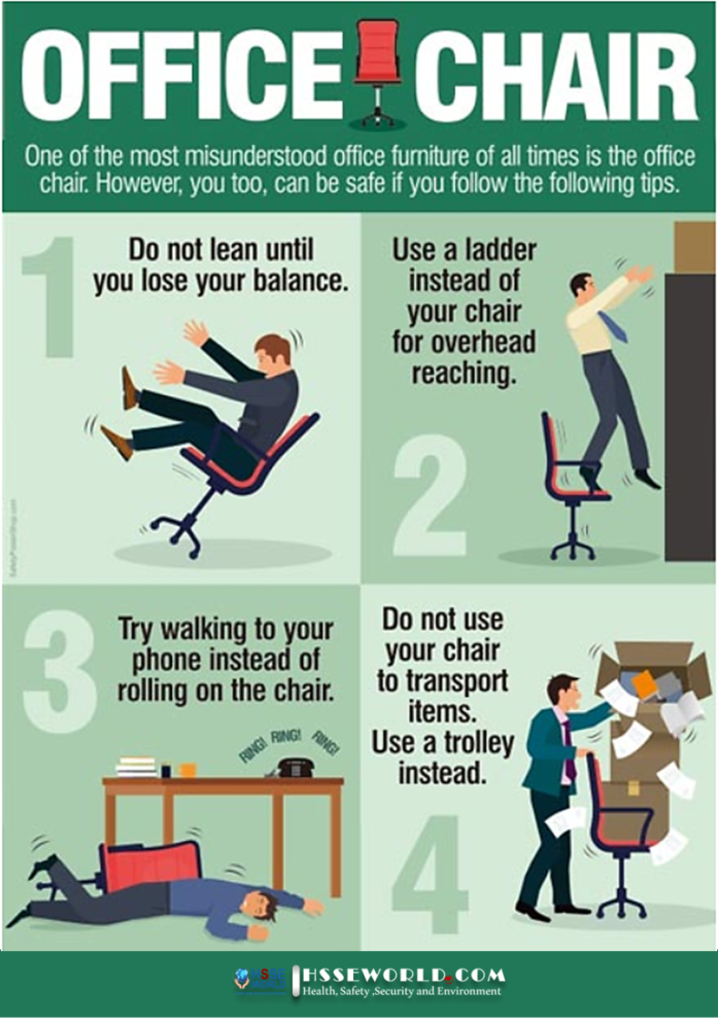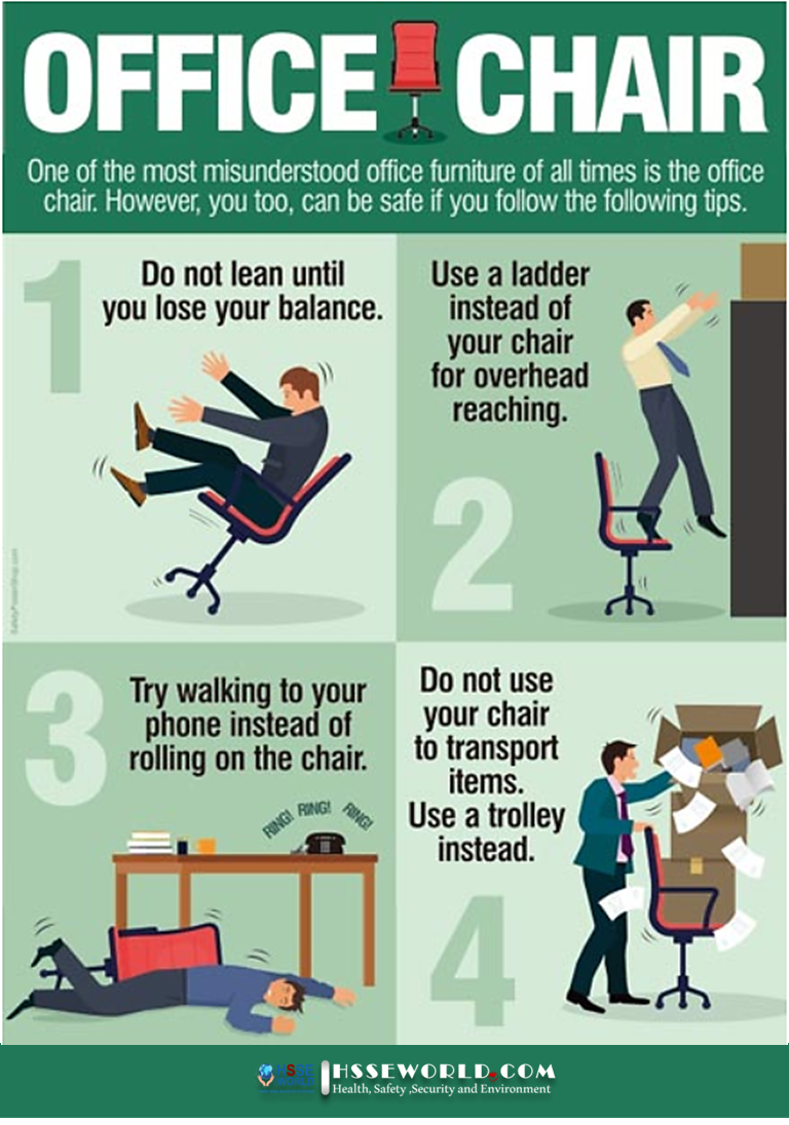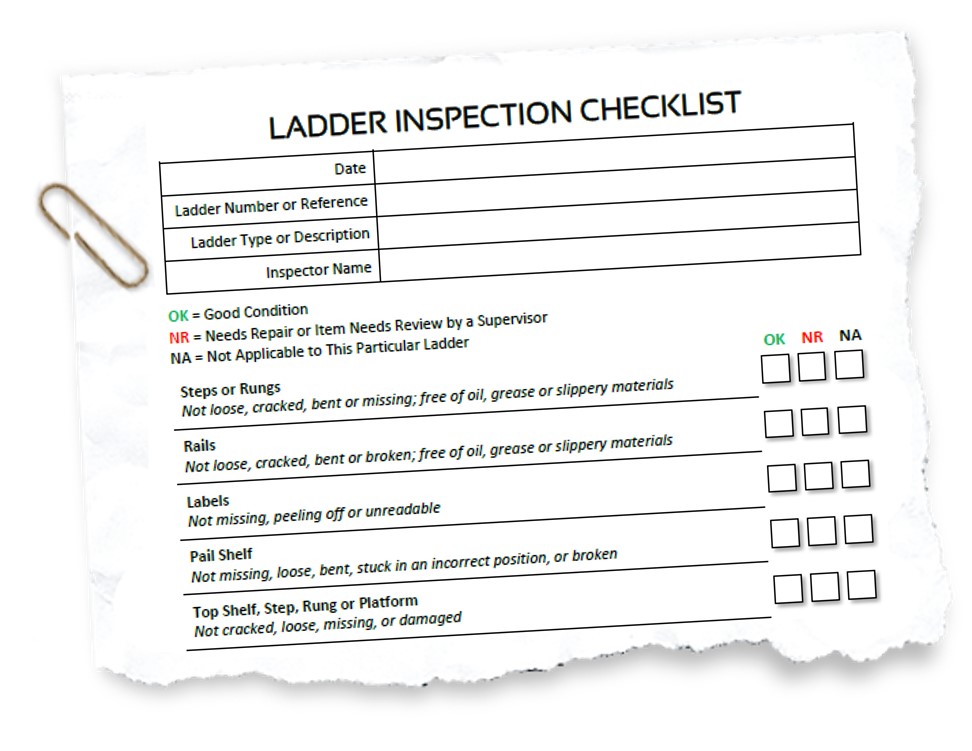Office chairs are an integral part of the workplace environment. Responsible for supporting us as we work and keeping us comfortable, these items play more of a role in our daily life than we often think. In fact It doesn’t matter if you’re super fit like Tom Brady or Peter Gennero, having good posture is essential for your back, legs, and neck. That’s why using these seats correctly is so important to maintaining your safety and physical health while in the office. In the photo of today few important office chair safety tips to know and how they can contribute to a better day on the job in addition to safety tips about Ergonomic chairs and how you select it.
Also Read: Photo of the day: Position for safety and comfort-Safety Tips

What is an ergonomic chair?
Chairs that are sold as “ergonomic chairs” are designed to suit a range of people; however, there is no guarantee that they will suit any one person in particular. For example, a chair could be too high and the arm rests too far apart for a short, slim person. In addition, chairs may not suit every task or arrangement at the workstation. A chair becomes ergonomic only when it specifically suits a worker’s size (body dimensions), their particular workstation, and the tasks that must be performed there. These factors must all be considered when deciding which chair to use.

Why is finding the right chair so important?
Injuries resulting from sitting for long periods are serious occupational health and safety problems. Sitting jobs require less muscular effort, but that does not exempt people from the injury risks usually associated with more physically demanding tasks. For example, clerks, electronic assembly-line employees, and data entry operators who work in a sitting position also suffer back pain, muscle tenderness, and aches. In fact, reports of varicose veins, stiff necks, and numbness in the legs are more common among seated employees than among those doing heavier tasks.
In addition, the sedentary time has been found to be associated with health effects such as metabolic syndrome (including diabetes), heart disease, and poor mental health. These effects are not related to how active a person is physical.
What do you need to know about selecting a good ergonomic chair?
With the ergonomics approach, sitting is viewed as a specific, specialized activity that is influenced by the way that a sitting person interacts with the working environment.
Several basic concepts should be considered:
- One chair does not fit everyone. The users’ body dimensions must be considered when selecting a chair so that the chair does not strain one part of the body while fitting another.
- Collect data about the user’s body height. The optimal seat height is about one-quarter of the body height. This estimate is only a rule of thumb since the torso-to-leg ratio can vary widely.
- There is no chair suitable for every activity. For example, dentists require a different chair than do industrial workers or computer operators.
- Consider maintenance and repair costs. Check with the manufacturer for items to inspect for and how often inspection should be done.
Also Read: Prevent Office Injuries(Opens in a new browser tab)
What are the features of a good chair?
Some features are important for a good chair regardless of how you intend to use it:
- Adjustability – Check to see that seat height is adjustable.
- Seat height range – Check whether the seat height can be adjusted to the height recommended for the worker(s) who will use it. Alternate chairs may have to be selected for very short or tall workers. Ideally, a user should be able to sit with their feet on the floor or on a footrest without pressure on the underside of their thighs.
- Backrest – Check to see that the backrest is adjustable both vertically and in the frontward and backward direction and has firm lumbar support, but does not create pressure points that restrict blood circulation. The backrest should be of appropriate height and width to provide support without restricting movement.
- Seat depth – Select the seats that suit the tallest and the shortest users. Users should be able to sit in the chair without pressure at the back of their knees, with their back supported by the backrest, and support through the buttocks and thighs.
- Seat width – The seat should be wide enough to allow users to have a comfortable and even pressure across the entire seat and allow for some adjustments to their posture.
- Seat angle – Where the angle of the seat is adjustable, the seat should allow users to support their feet on the floor or footrest. Forward sloping seats should have a surface that has enough friction to prevent the user from sliding out of the chair or placing too much weight on their feet.
- Seat surface – The seat surface should be comfortable, usually made of breathable materials that minimize heat and moisture buildup. In some workplaces, such as healthcare or laboratories where infection control is a concern, other materials may be more appropriate.
- Armrests – armrests should provide support and evenly support the arms. The rests should be adjustable both for height and width (distance from the seat). In other situations, armrests may not be helpful if they prevent a person from sitting close enough to the desk and keyboard. Adjust or remove armrests, as needed.
- Stability – Check for the stability of the chair; a five-point base is recommended.
Other features to consider
- See if the selected chair has features that will help someone do their job better. Arm rests with adjustable heights are good for computer operators. Wider or narrower arm rests may also be required depending on the worker’s dimensions and the tasks they do.
- See if the selected chair has features that will make doing a job more difficult. An example may be that someone may be using a chair with casters or wheels when a stable and stationary work position would be better. If chairs with casters are needed, choose ones that match the type of flooring you have (e.g., hard casters for carpeting or soft casters for hard floors). Determine if there is a need to have brakes on the casters.
- The user should be able to operate the controls from a seated position where practical and be logical in their placement and function.
Who should pick out the chair?
Personal preference is essential to the process of selecting a chair.
- After some suitable chairs have been identified, allow the person who will use the chair most to try out the chair in a real work situation. It is especially useful to obtain several sample chairs for a trial comparison by those who will be using them.
- Make sure that the chair meets the needs of the workers and their jobs before any final selection is made.
Can a chair solve all of the ergonomic problems of working in a sitting position?
A well-designed chair allows the user to sit in a balanced position. Buying an ergonomic chair is a good beginning but it may not bring the benefits expected. It is still important to sit properly.
Also, remember that the chair is only one of the components to be considered in workstation design. All the elements such as the chair, footrest (if needed), work surface, document holders, task lighting and so on need to have flexibility and adjustability to be “designed in”.
In addition, workers should be made aware of the health hazards of prolonged sitting and give recommendations on what a worker in a given workplace can do to improve their working position. Employees need to know how to adjust the workstation to fit their individual needs for specific tasks. They also must know how to readjust the workstation throughout the day to relieve muscular tension.
Emphasize the importance of “rest” periods for their health and explain the importance of “active” rest. For example, a worker’s duties can include opportunities to stand, walk, or otherwise move around in order to reduce the amount of time spent sitting. Where practical, jobs should incorporate “activity breaks” such as work-related tasks away from the desk or simple exercises that employees can carry out on the worksite.
Also Read: Hidden Hazards:25 steps to a safer office -Safety Moment #15
Office Chair Safety Tips
Everyone knows sitting for 8 or more hours a day is bad for your health. Yet there are other workplace health issues caused by office chair the following Safety Tips shall be considered during using Office Chair:
Don’t Use Broken Chairs
If a chair is missing a wheel or armrest, is “stuck” at one height, or sits at an uncomfortable angle, the chair is broken. Even if the chair seems safe, it could easily tip or break further with continued use. It is better in the long run to buy a new chair than repeatedly dealing with a dangerous chair. Consider upgrading to a fully functional used chair or a brand new office chair as soon as you can.
At the start of the workday, employees should take a few minutes to adjust the headrest, armrests, and overall height of their chairs. Doing this in the morning means there shouldn’t be distractions later in the day from an uncomfortable seat.
Don’t Tip the Chair
If you spend the day leaning over to see other people’s work or like to kick up your feet, you’re in danger of tipping your chair. A fall of even 1-2 feet can lead to sprained or broken bones. Keeping a chair level will reduce this risk.
Take a Break
Continuously sitting is incredibly bad for long-term health. Workers should stand up and take a quick walk at least once an hour. If they work with computers, this is a good opportunity to rest their eyes from monitor strain.
Don’t Sit in Pain
Really need to finish an assignment? Sitting through your discomfort might seem like no big deal, but staying seated can lead to more pain in the future. Chair discomfort can be a major distraction while working, so it is better to get up and relax your body before finishing that big project.
Chairs with wheels are incredibly convenient yet create an office hazard. Someone who sits down might not expect the chair to begin rolling and hurt themselves.
Office Chair Weight and Height Limits
The type of chairs needed at your office will depend on your workers. Office chairs from Bern Boys are built sturdier than ever to support employees of all sizes. Weight capacity is a real issue to take into consideration when buying new chairs. On average, most work chairs can support up to 250 pounds. There are now big & tall style chairs available with up to 500 lb. or more.
Smaller workers will also need to be taken into consideration. A short employee may require a low chair so their feet can touch the ground comfortably while they work. Keeping feet flat on the floor is recommended for better ergonomic support.
Also Read: Photo of the day: Top10 Injuries in office work
Download the Infographic
Now you can download the Infographic ” Office Chair safety” and post it at the workplace to communicate with everyone to be familiar with the Safety Tips of using office chairs to avoid any injuries or incidents occures.
Photo of the day: Office Chair Safety Tips
Download more resources at SAFETY BAG
More photos:
- What are the Best Practices for Managing Subcontractor Risk
- Photo of the day: 10 Essential Safety Tips for Driving in Hot Weather Conditions
- Photo of the day: best workplace safety tips
- Photo of the day: The Importance of Stop Work Authority in Maintaining Workplace Safety
- Photo of the day: Tomorrow’s Reward for Working Safely Today: Cultivating a Culture of Safety
- Photo of the day: Preventing slips and trips at work
- Photo of the day: Learn the DRSABCD action Plan
- Working with Electricity Electrical Accidents Guide for Electrical Workers
- Photo of the day: Hearing Protection Device Selection
- Photo of the day: If An Earthquake Shakes You-Infographic free
- Fire Safety Posters Free Download
- Photo of the day: First Aid for Electrical Burns-Infographic free
- Infographic: First Aid for Cuts and Scrapes free download
- Photo of The day: Work Safe with Lasers-Laser Safety free
- Photo of the day: Working Safely with chemicals and chemical Management
- Photo of the day: Safe work practices when using MEWPs ( updated)
- Photo of the day: Preventing Common Kitchen Hazards
- Photo of the day: Safe handling of Gas Cylinders and lecture bottles
- Photo of the day: Forklift Stability Triangle
- Photo of the day: Defective Tools Safe Work Practice
- Photo of the day: Lift With Your Legs Not With Your Back
- Photo of the day: First Aid for burns
- Photo of the day: The 7 Principles of HACCP
- Photo of the day: Working Safely with Suspended Loads
- Photo of the day: Heat Stroke First Aid and safety posters
- Photo of the day: Near-Miss Reporting and Posters
- Photo of the day: Ergonomic chair and office chair safety tips
- Photo of the day: Whole Body Vibration
- Photo of the day: Substation Safety Equipment
- Photo of the day: Bypassing Safety Controls Rules
- Photo of the day: Lightning Safety Tips
- Photo of the day: Overhead Power lines Clearance
- Photo of the day: Floor Marking
- Photo of the day: Types of Foot Protection
- Photo of the day: Types of Hand Protection
- Photo of the day: Lockout and Tagout Safety
- Photo of the day: Fall Protection Plans
- Photo of the day: Flood Safety Tips
- Photo of the day: Read All Labels Work safe
- Photo of the day: Run Project safely with Crane Hand Signals
- Photo of the day: Flagman and Traffic control
- Photo of the day: Managing Risks of Exposure to Solvents in the workplace
- Photo of the day: Scissor Lift Safety
- Photo of the day: HSE Bulletin Board
- Photo of the day: Arc-Fault Circuit Interrupters (AFCI)
- Photo of the day: Safe use of ladders and step ladders
- Photo of the day: Concrete Truck Driver Hand Signals
- Photo of the day: Extension Cord Safety Tips
- Photo of the day: Protect your Head
- Photo of the day: choosing the right Anchorage
- Photo of the day: Work-Related Asthma
- Photo of the day: Top FIVE Heavy Equipment Construction Site Safety Tips
- Photo of the day: sun safety in the workplace
- Photo of the day: Cannabis and Impairment in the Workplace
- Photo of the day: Position for safety and comfort-Safety Tips
- Photo of the day: Generator Safety
- Photo of the day: Controlling COVID-19 in the Workplace-Physical Barriers
- Photo of the day: Manual Material handling
- Photo of the day: Personal Protective Equipment last resort
- Photo of the day: WHMIS 2015 – Pictograms
- Photo of the day: Indoor Air Quality
- Photo of the day: Noise in the affected workplace
- Photo of the day: Fatigue at Work
- Photo of the day: Don’t be Driven to Distraction
- Photo of the day: working in heat and Humidex Rating
- How to use Plate Clamps Safely: Safety Moment#34
- Photo of the day: Sitting at work
- Photo of the day: 5 ways to reduce the risk of Slipping and Tripping
- Photo of the day: Preventing the spread of contagious illness
- Photo of the day: Incident Investigations
- Photo of the day: 10 Scaffold Safety Essentials
- Photo of the day: Effective Health and Safety Committees
- Photo of the day: New worker Orientation & Safety Orientation checklist
- Photo of the day: Workplace Inspection
- Photo of the day: musculoskeletal disorders
- Photo of the day: Emergency preparedness in the workplace
- Photo of the day: Mental health in the workplace
- Photo of the day: Trenching Safety Tips That Can Save a Life
- Photo of the day: Dangerous Goods Classes
- Photo of the day: Safety Equipment for Confined Spaces
- Photo of the day: Tips to reduce Heat stress in the workplace
- Photo of the day: hierarchy of controls
- Your steps to chemical safety
- H2S Gas and how to handle its Emergency
- Photo of the day: Importance of Mock drill and Fire Action Emergency Procedure
- Photo of the day: Choosing the Right Face Mask and the difference between a respirator and face mask
- Photo of the day: Confined space safety Precautions
- Breath Safely: The Proper Use of Respiratory Protection
- Photo of the day: Electric shock survival
- Photo of the day: Chemical Spill Emergency Response
- Photo of the day: Construction Site fire Safety
- Photo of the day: Confined Space rescue
- Photo of the day: Conveyors Safety Tips





